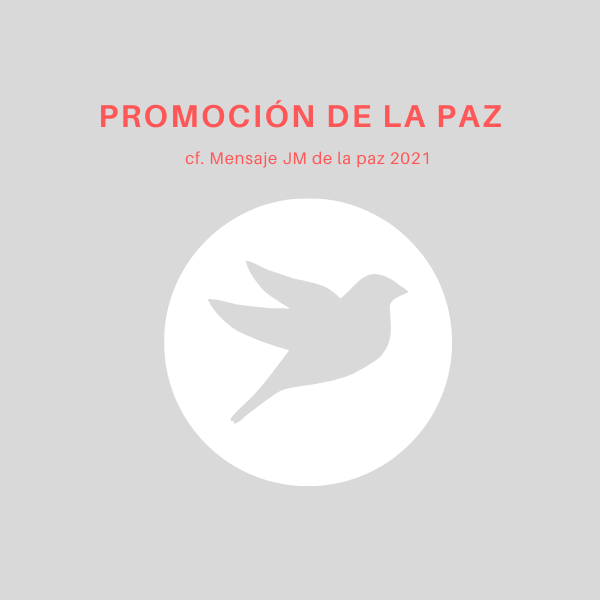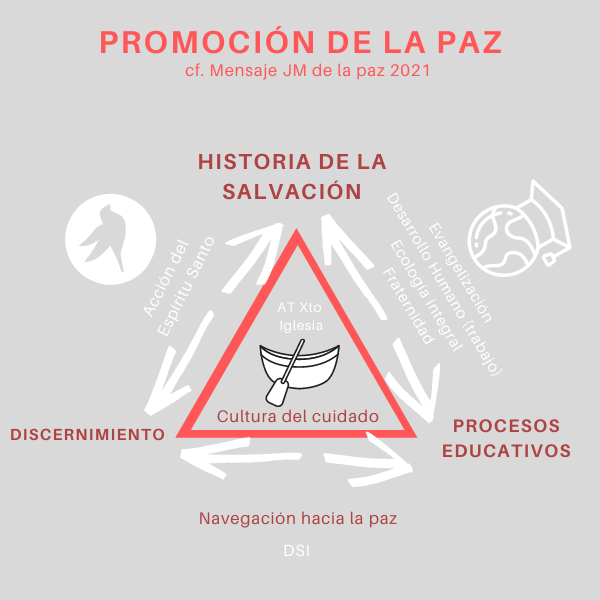
In fact, at the beginning of his pontificate, Francis presented St. Joseph as the one who took care of the salvific project centered on Christ. And he did so by means of his own discernment, based on the signs of the action of the Holy Spirit that are perceived when one looks at events with faith and realism.
The image chosen by the Pope is the navigation towards peace, which is our port or our goal.. That is where we are sailing, "we are all in the same boat", as he points out in Fratelli tutti. Months earlier, on March 27, he had said that the pandemic has made us aware of being in a fragile and disoriented boat. Now we can clearly see that the boat is or should be fraternity, the path is justice and the course is peace. The Pope wishes that humanity "may progress in this year on the path of fraternity, justice and peace".
First of all, it may be useful to recall what peace is in the perspective of Christian anthropology, with its biblical roots. In the seventh beatitude, the peacemakers are declared blessed.The reason given is that they will be called children of God. And the reason given is that they will be called children of God. That beatitude is an echo of the fullness expressed on the seventh day of creation, when God rested and saw that everything was not only good, but "very good".
On Shabbat, the seventh day, man is invited to join God's rest. Hence the greeting among the Jews, schalom, which recalls and reactivates that peace, a greeting that is reinforced on Saturday, Shabbat schalom, wishing that day especially the peace that comes from God. In biblical culture and language, the opposite of that peace is sin.that is to say, disorder and the negation of love. And all this applies to things, people and society.
Christians see this from the fruits of the paschal mystery. Jesus is the prince of peace (prophesied in Is 9:6), also from his years of labor and ordinary life in Nazareth.
To work and make peace is to imitate and consider, to collaborate with what God does in his plan of salvation.. Building peace has a lot to do with working well, in tune with the Lord, in tune with people, seeking harmony and unity of life, in the perspective of Christian anthropology.
The Pope's message can be analyzed by following the steps of the discernment methodwhich he has ever named as follows: contemplate, discern, propose.
Francisco is particularly interested in the context of CovidIt is also a time of drama (health, economic, etc.) and light (the hidden heroism of so many, testimonies of charity and solidarity). And it renews the call to its ethical aspects (access to vaccines and technologies).
Points out some obstaclesThe following are some of the most common forms of nationalism, racism, xenophobia, and even wars and conflicts. And above all the ways: "To take care of each other and also of creation, in order to build a society based on fraternal relationships".. Hence the motto of this message "The culture of care as a path to peace".
It directly explains the purpose of this "Culture of Care": to eradicate the culture of indifference, rejection and confrontation that prevails today.. It is a navigation in that fraternity boatWe are on the road to justice and on the road to peace.
Put a face to your donation. Help us form diocesan and religious priests.
The foundations and criteria for discernment can be found in revelation, in the signs of the times, in the human sciences and always in the present situation.
These foundations or criteria are grouped here in two types. Some refer to salvation history and others refer to the history of salvation. the social doctrine of the Church.
On the history of salvation. This story teaches and promotes "care" in relation to God, oneself, others (fraternity and justice) and at the same time to the Earth.. In this perspective, Adam (the man related to the Earth) and his task of cultivating and caring for it is named (cf. Gen 2:15). The figure of Cain, who "excuses" himself for not having been his brother's keeper (cf. Gen 4:9). And above all, God's own care for Cain (cf. Gen 4:9), his instructions about the Sabbath rest in relation to worship and at the same time to the social order and the poor (cf. Deut 15:4). Also the preaching of the prophets, such as Amos and Isaiah, along the same lines.
One more step, and a definitive one, is the life of Jesus and the "care" in his ministry, namely his love and compassion for the poor and needy.. Let us recall his first preaching in the synagogue of Nazareth (Lk 4:18), his identification as the Good Shepherd (cf. Jn 10:11-18; Ez 34:1-31), his teaching on the mercy of the Good Samaritan (cf. Lk 10:30-37: do likewise) and, finally, his self-giving: the gift and sacrifice of his life on the Cross and the invitation to follow him along that path.
This culture of care was learned by the followers of Jesus. There is the insistence of the Church on the works of mercy, since the first Christians (cf. Acts 4:34-35). The teachings of the Fathers on the common good and the sense of ownership of goods. And so many institutions that have arisen since then precisely for the care of the most needy.
Criteria of the Church's social doctrine are presented, which assume and concretize the previous ones as the foundations or fundamental criteria of the culture of care:
1) human dignity (the concept of person and the exclusion of its manipulation, with Christian roots; rights and duties in relation to others);
2) the common goodwhich corresponds to the entire human family;
3) solidarityThe common good and responsibility for all (cf. encyclical Fratelli tutti);
4) protection of creationpeace, justice and the preservation of creation, inseparable from tenderness, compassion and concern for every human being (cf. Encyclical Laudato si').

As a conclusion of the discernment, the pope proposes that these principles represent the compass for a common course, a "truly human course": the path of peace and humanization, following the principles of the Church's social doctrine.
Already within the concrete proposals, Francis points out the importance of promoting processes, and in this case specifically educational processes, to strengthen the dynamics "within the common boat", which is fraternity. That is, the dynamic between social friendship and fraternity. We can point out, according to Evangelii gaudium, Fratelli tutti and Laudato si', and in the current context that includes the pandemic, that these educational processes imply: an anthropology, an ethics (we return to social principles), openness to others, discernment and dialogue in search of "lived truth".
All this, together with a faith education to assume those values and paths. And in that way, in the boat, let us bear witness that we are with Christthat lives, although sometimes it may seem that it sleeps, but has the power to calm the storm o make us walk on the waters, and bear much fruit, reaching port with the humanity entrusted to us.
This will have to be translated into concrete projects at the universal and local levels: in the family, the parish and the school, in the university, in relation to religions and in collaboration with other educators (educational pact), who know how to highlight the values (valuable contents) and the paths of human reality and creation.
This approach could be represented by the figure of a triangle at the bottom of which is the culture of care as the key to navigating towards peace.. This culture is continuously rooted and built from the history of salvation (upper vertex), discernment (left vertex) and concrete educational processes (right vertex). At the same time, the culture of care feeds back into the living processes that link God's action to human actions.. Between the upper vertex (salvation history) and the left vertex (discernment), the action of the Holy Spirit can be highlighted. On the other side (right), that same living history of salvation continues to interact in educational processes, through evangelization, human development (work-driven) together with integral ecology, and fraternity. Educational processes, in turn, are placed in dynamic relationship with discernment (base of the triangle), in this "navigation of peace", which is guided by the principles and criteria of the Church's social doctrine.
(This text is a synthesis of the content presented, in the form of an interview, in a telematic session organized by the Department of Pastoral and Culture of the Mexican Episcopal Conference and transmitted on January 12, 2011).
Mr. Ramiro Pellitero Iglesias
Professor of Pastoral Theology
Faculty of Theology
University of Navarra
Published in "Church and new evangelization".